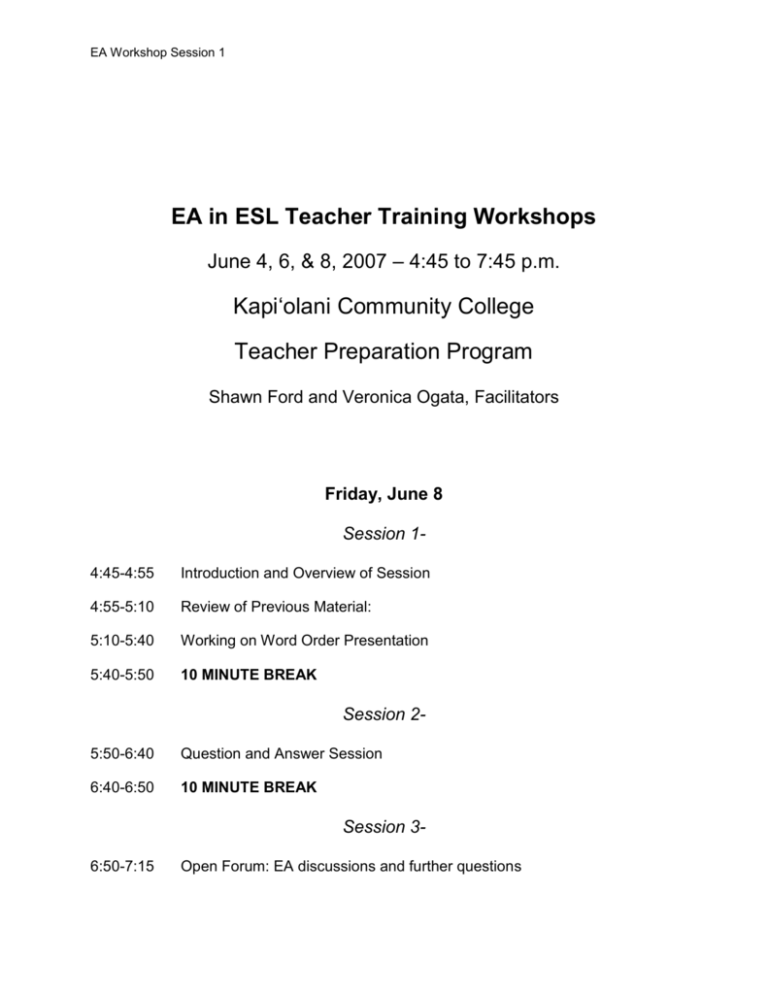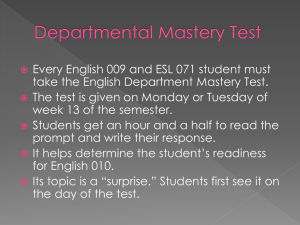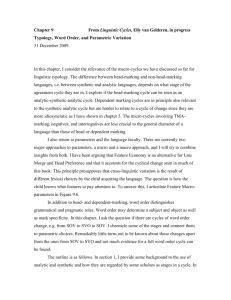EA in ESL Teacher Training Workshops
advertisement

EA Workshop Session 1 EA in ESL Teacher Training Workshops June 4, 6, & 8, 2007 – 4:45 to 7:45 p.m. Kapi‘olani Community College Teacher Preparation Program Shawn Ford and Veronica Ogata, Facilitators Friday, June 8 Session 14:45-4:55 Introduction and Overview of Session 4:55-5:10 Review of Previous Material: 5:10-5:40 Working on Word Order Presentation 5:40-5:50 10 MINUTE BREAK Session 25:50-6:40 Question and Answer Session 6:40-6:50 10 MINUTE BREAK Session 36:50-7:15 Open Forum: EA discussions and further questions 715-7:45 Wrap-up, Feedback Form, and EA Survey WELCOME! Welcome to the last night of the EA in ESL Teacher Training Summer Workshops, sponsored by the new Teacher Preparation Program at Kapi‘olani Community College and funded in part by a federal Perkins grant. This workshop series is prepared for in-service Educational Assistants who work with NEP and LEP students in the state’s DOE system. The purpose of the workshop is to provide EAs with additional training in the form of knowledge and strategies that will help them better facilitate and accelerate the language development of the ESL students who they work with regularly. We hope you have enjoyed our program and find the information and ideas useful for your teaching efforts! During the workshop, please remember to… 1. Actively participate and be open to new ideas. 2. Stay on task so we can complete the material in each session on time. Remember, throughout the workshop, we are guided by the following Language Development Maxims: 1. Language should not be taught in isolation. Language should always be taught in some sort of context, using meaningful content. Any attention to discrete skills should arise from content demands. 2. Learner-directed speech should always encompass BICS and CALP. This can be accomplished by using complete sentences to facilitate interaction. Repetition and recasting, along with expansion of ideas and the encouragement of inquiry should be part of all feedback. Bloom’s Taxonomy: 1 Knowledge: arrange, define, duplicate, label, list, memorize, name, order, recognize, relate, recall, repeat, QuickTime™ and a TIFF (LZW) decompressor are needed to see this picture. reproduce state. 2 Comprehension: classify, describe, discuss, explain, express, identify, indicate, locate, recognize, report, restate, review, select, translate, 3 Application: apply, choose, demonstrate, dramatize, employ, illustrate, interpret, operate, practice, schedule, sketch, solve, use, write. 4 Analysis: analyze, appraise, calculate, categorize, compare, contrast, criticize, differentiate, discriminate, distinguish, examine, experiment, question, test. 5 Synthesis: arrange, assemble, collect, compose, construct, create, design, develop, formulate, manage, organize, plan, prepare, propose, set up, write. 6 Evaluation: appraise, argue, assess, attach, choose compare, defend estimate, judge, predict, rate, core, select, support, value, evaluate. Stress: A great body of research has shown that if a second language learner accurately produces the stress of the word on the correct syllable, then the learner is better understood. Take for example the word “accurately”, which has stress on the first syllable. In some languages, stress normally falls on the penultimate (next to last syllable), resulting in the pronunciation accurately. Schwa Shift: In Standard American English, in unstressed syllables, the vowels a, e, i, o, and u have a tendency to be reduced to the schwa, which is the first sound in the word “enough”. Common noun- verb pairs of words with this phenomenon include: research - research protest - protest Vocabulary Profiler: http://www.lextutor.ca/vp/eng/ EA Workshop Materials: http://www2.hawaii.edu/~sford/esl/EA_workshop.html Word Order in Linguistics The English language follows a very predictable SUBJECT – VERB – OBJECT word order. Also, when modifying nouns, adjectives always precede the noun. Adverbs are rather flexible and can occur in most places in a sentence except in front of a noun. However, other languages may follow other word order rules. Chinese - SVO Ilokano – VSO Japanese - SOV Korean - SOV Samoan - VSO Vietnamese - SVO Word Order and ESL Here are some issue to consider for ESL students and word order: Instruction on word order must be taught in context. Research on the acquisition of word order shows us that second language students learn word order, phrase structure and clause structure in predictable sequences. Decisions about instruction in word order should be driven by naturally occurring structures in the content. Linking Word Order to Vocabulary instruction Any isolated instruction on word order should be with NEP or low-level LEP students only. Afterwards, be sure to link the word order to context and production. Try to teach word order from the most basic to the most difficult. For example, teach the simple SVO order before teaching noun and verb phrases. Teach about noun and verb phrases before teaching adverbials or relative clauses. LEP students can likely only understand simple phrases structure anyway. Focus on word order structures that occur naturally in the content. Try not to follow a curriculum that teaches word order and phrase order in a strict developmental order. Sample Activity: Word Order Development Content: American History – course textbook Context: 10th grade, Ilokano, Marshallese, and Samoan after-school ESL Skills: reading, speaking, listening, writing Lesson Plan Overview: 1. Choose vocabulary items based on the required context 2. Visual recognition of symbols: reading the words 3. Aural distinction of sounds: listening to the words 4. Written distinction of words: writing the words 5. Production: selecting the words + feedback 6. Production: saying the words + feedback 7. Production: writing the words + feedback 8. Awareness-raising & practice: a. Basic SVO word order b. Simple noun, verb and prepositional phrase structure c. Collocations 9. Production: speaking in context 10. Feedback & Reinforcement 11. Production: writing in context 12. Feedback & Reinforcement Lesson Plan Demonstration: Word Order Development The United States is sometimes referred to as a "nation of immigrants." You may have also heard the phrase "melting pot." In its short history the United States has seen many waves of immigrants come to its shores and borders. For reasons such as political or religious persecution or in search of better economic conditions, many people have fled their native lands to live in America, the land of the free. This has resulted in a very diverse U.S. population. People living here have different heritages, religious beliefs, ethnicity, languages, and national origins.Though there are these differences, Americans are bound together by basic political values and principles described in historical documents.










